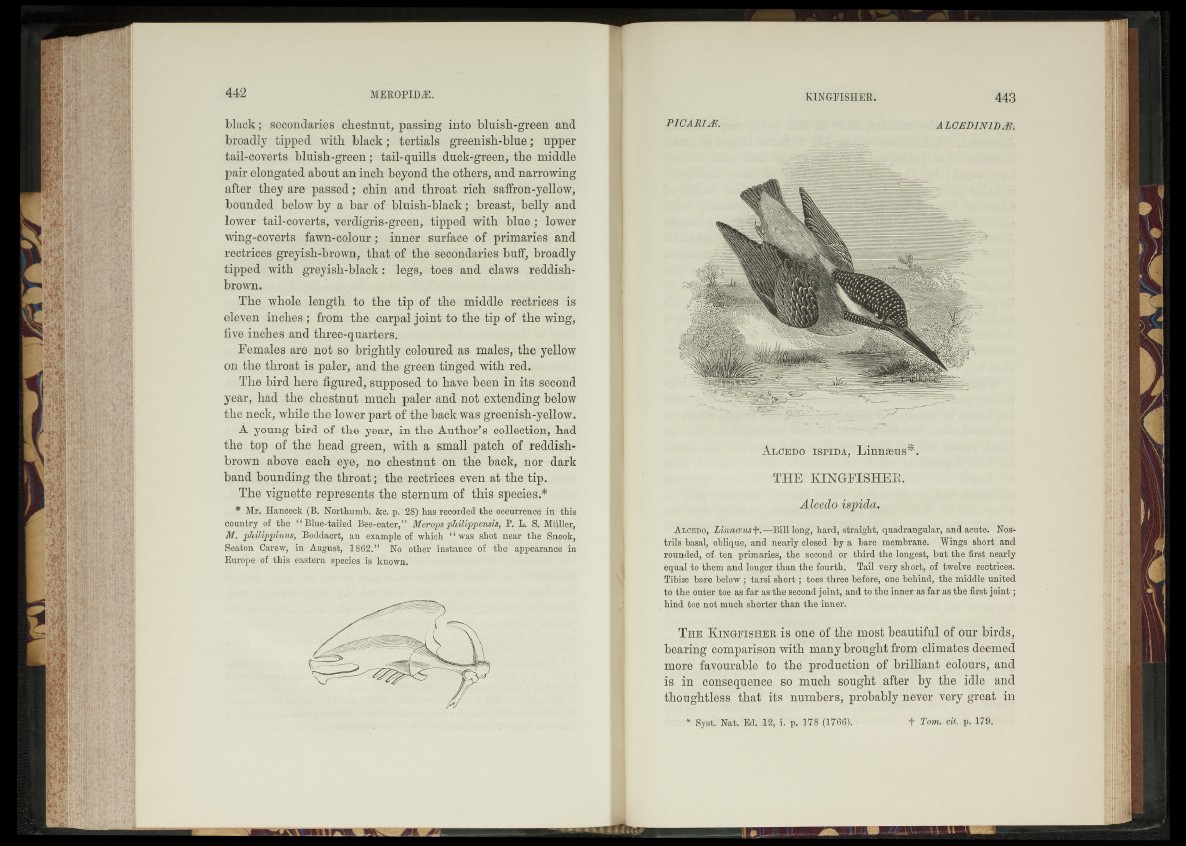
black; secondaries chestnut, passing into bluish-green and
broadly tipped with black; tertials greenish-blue; upper
tail-coverts bluish-green; tail-quills duck-green, the middle
pair elongated about an inch beyond the others, and narrowing
after they are passed; chin and throat rich saffron-yellow,
bounded below by a bar of bluish-black; breast, belly and
lower tail-coverts, verdigris-green, tipped with blue; lower
wing-coverts fawn-colour; inner surface of primaries and
rectrices greyish-brown, that of the secondaries buff, broadly
tipped with greyish-black: legs, toes and claws reddish-
brown.
The whole length to the tip of the middle rectrices is
eleven inches; from the carpal joint to the tip of the wing,
five inches and three-quarters.
Females are not so brightly coloured as males, the yellow
on the throat is paler, and the green tinged with red.
The bird here figured, supposed to have been in its second
year, had the chestnut much paler and not extending below
the neck, while the lower part of the back was greenish-yellow.
A young bird of the year, in the Author’s collection, had
the top of the head green, with a small patch of reddish-
brown above each eye, no chestnut on the back, nor dark
band bounding the throat; the rectrices even at the tip.
The vignette represents the sternum of this species.*
* Mr. Hancock (B. Northumb. &c. p. 28) has recorded the occurrence in this
country of the “ Blue-tailed Bee-eater,” Merops philippensis, P. L. S. Miiller,
M. philippmus, Boddaert, an example of which f ‘ was shot near the Snook,
Seaton Carew, in August, 1862.” No other instance of the appearance in
Europe of this eastern species is known.
PICARIAS. A L CEDIN1 DAE.
A l c e d o is p id a , Linnaeus*.
THE KINGFISHER.
Alcedo ispida.
Alcedo, Linnce.usf.—Bill long, hard, straight, quadrangular, and acute. Nostrils
basal, oblique, and nearly closed by a bare membrane. Wings short and
rounded, of ten primaries, the second or third the longest, but the first nearly
equal to them and longer than the fourth. Tail very short, of twelve rectrices.
Tibiae bare below ; tarsi short; toes three before, one behind, the middle united
to the outer toe as far as the second joint, and to the inner as far as the first jo in t;
hind toe not much shorter than the inner.
T h e K in g f i s h e r is one of the most beautiful of our birds,
bearing comparison with many brought from climates deemed
more favourable to the production of brilliant colours, and
is in consequence so much sought after by the idle and
thoughtless that its numbers, probably never very great in
* Syst. Nat. Ed. 12, i. p. 178 (1766). + Tom. cit. p. 179,